Comité des Étudiants Américains de l'École des Beaux-Arts Paris
.Comit%C3%A9_des_%C3%89tudiants_Am%C3%A9ricains_de_l'%C3%89cole_des_Beaux-Arts%2C_un-numbered_post_card%2C_by_an_artist_not_yet_identifed.WWI_postcard_art.Wittig_collection.item_37.reverse.scan.jpg)
The Comité des Étudiants Américains de l'École des Beaux-Arts Paris (C.E.A. à l’E.D.B.A.; The Committee of American Students of the School of Beaux-Arts, Paris) was, as the name indicates, an organization of American art students at the Ecole des Beaux-Arts in Paris; American alumni of the school were also involved. It was active as a war and war-relief charity during World War I; operating from at least 1916 through the end of the war. The group was strongly Francophile. Among other activities, they raised funds through the production and sale of art-postcards.
Overview
The Comité des Étudiants Américains de l'École des Beaux-Arts Paris, an organization of American art students at the Ecole des Beaux-Arts in Paris, was set up as a war and war-relief charity in support of the French cause in World War I; operating from at least 1916 to early 1919. American alumni of the school were also involved.
A primary focus of their charitable activities was providing help to fellow art students who were serving in the armed forces, and to those students' families. They also supported other efforts, including more directly military causes.
The committee raised funds by organizing the production, exhibition, and sale of art-postcards; created by professional French artists, as well as by students. Later, they also published a periodical; the Gazette de l'Ecole des Beaux-Arts. The group had other sources of funding as well.
As well as their charitable activities, and fund-raising for those activities, the group's efforts and products helped to express and promote sympathy for France (and occupied Belgium) during the war; particularly among Americans. This was one of many efforts by Francophile Americans in France and the United States in support of the French and Allied cause; both before and after their own country entered the war.
Notable American architect and École des Beaux-Arts alumnus Whitney Warren was one of the organization's founders. Another key organizer was (Frank) Ronald Simmons (1885-1918), the son of a wealthy Rhode Island industrialist, who became a very close friend of Edith Wharton. After his sudden death from influenza, he became the basis for the character of "Boylston" in her War novel "A Son at the Front" (written in 1919, published in 1923). War charity work, and the involvement of Americans in it, are mentioned; but the Comité is not described specifically.
It should be noted that the name 'Comité des Étudiants Américains de l'École des Beaux-Arts Paris' is generically descriptive in French. There were very likely associations of American students at the Ecole des Beaux Arts in Paris, both before and after the war, who may have used the same, or similar, names. There were certainly other associations of American students at various schools throughout France, many of whom participated in efforts to help the French cause in various ways, during the war. Also, there were myriad other "Comités". Additionally, student organizations frequently published periodicals, and the term "gazette" was not uncommon in the titles of these publications. That said, the Comité des Étudiants Américains de l'École des Beaux-Arts Paris which was active during the First World War was a specific organization run by a specific group of people, that engaged in particular activities in charity and the arts during the war; and it has left behind an artistic "body of work(s)" relevant to the period.
Postcards
The committee of students raised funds by organizing the production, exhibition, and sale of art-postcards; created by professional French artists, as well as by students. Production of the cards began in 1916, and continued through the end of the war.
Their postcards covered a range of subjects; from war scenes and war ruins, to typical tourist views, and sometimes other types of artistic images, in a variety of styles. The levels of effort, detail, technical skill, and artistic merit shown in the cards varies widely. Some of them are highly finished, others are more like rough "sketches"; although the tendency is for the post cards to be "ready and presentable for sale", as suits their intended purpose. The works include original drawings and paintings, as well as low-volume printed-works such as engravings, etchings, etc. For the most part, it's clear that they have been created by professionally trained artists, of the French school, and of the period. The Comité post cards are typically signed by the artist, often with a date, and usually included some description of the subject.
The backs of the postcards are marked with a printed inscription "The Comité des Étudiants Américains de l'École des Beaux-Arts Paris guarantee the authenticity of this post card". Most of the cards have a specific and fairly elabourate printed design on the reverse side, which includes graphical elements as well as the inscription. These card-backs are monochrome-printed in coloured ink; ink colours ranging from rusty-brown to yellow-orange were used. The design is signed at the bottom-centre, to the left of the canon, but the name tends to be illegible; possibly it is "R.TRUBON", or "R. TRUDON". The pattern was, however, unsuitable for postal use; in that it did not conform to international standards for postcard formats. Sometimes the word "picture" is used instead of "post card" on these card-backs; possibly as a late variant.
Most, but not all, of the cards were hand-numbered on the back in what appears to be a straightforward numerical count. Based on the numbers and dates of known examples, and assuming the numbering is by a simple-count system, the total number of postcards created was probably around 40,000.
After the war, at least 1 book was published showing a selection of the best postcards produced by the Comité; as determined by the book's editors (bibliographical information is pending).
The New Mexico State University - Archives and Special Collections Center has an album of 398 of the post cards in their collection; this material is not presently available online (as of 2015). At least a few of the cards are also listed in the archive collections of other public institutions. Comité postcards can also be found listed for sale online in small numbers, by various dealers, at different websites, and at a range of price-levels; however there does not appear to be any kind of organised collector-interest or particular "market-demand" for the cards.
Gallery
Un-numbered postcards
Un-numbered cards are presented in estimated approximate chronological order.
-
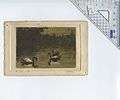
VERSAILLES - (swans in the water) - by "Gandon" - "2 12 16"
-
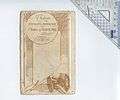
Reverse of previous card; un-numbered
-
.Comit%C3%A9_des_%C3%89tudiants_Am%C3%A9ricains_de_l'%C3%89cole_des_Beaux-Arts%2C_un-numbered_post_card%2C_by_an_artist_not_yet_identifed.WWI_postcard_art.Wittig_collection.item_37.obverse.scan.jpg)
Obverse of the card show above -- 1916-06-24
-
.Comit%C3%A9_des_%C3%89tudiants_Am%C3%A9ricains_de_l'%C3%89cole_des_Beaux-Arts%2C_un-numbered_post_card%2C_by_an_artist_not_yet_identifed.WWI_postcard_art.Wittig_collection.item_37.reverse.scan.jpg)
Reverse of previous (as seen above); un-numbered
Numbered postcards
Numbered cards are presented in numerical order; dates may be out-of-sequence.
-
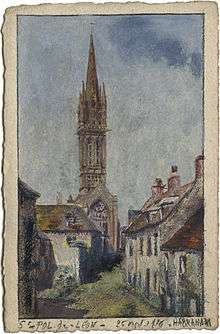
Kreisker chapel -- 1916-11-25
-

Reverse of previous; numbered 17712
-
uines_de_La_Guerre.Comit%C3%A9_des_%C3%89tudiants_Am%C3%A9ricains_de_l'%C3%89cole_des_Beaux-Arts_Paris_post_card_numbered_21221%2C_by_Alexandre_Bertin.WWI_postcard_art.Wittig_collection.item_39.obverse.scan.jpg)
War ruins in Chevincourt, in winter; by Alexandre Bertin.
-
uines_de_La_Guerre.Comit%C3%A9_des_%C3%89tudiants_Am%C3%A9ricains_de_l'%C3%89cole_des_Beaux-Arts_Paris_post_card_numbered_21221%2C_by_Alexandre_Bertin.WWI_postcard_art.Wittig_collection.item_39.reverse.scan.jpg)
Reverse of previous; numbered 21221
-
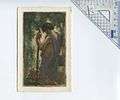
Pastoral scene of a shepherd-boy and one of his sheep, by Jean Souverbie; circa 1917
-

Reverse of previous; numbered 24800
-
Dupuy.WWI_postcard_art.Wittig_collection.item_40.reverse.scan.jpg)
Reverse of previous; numbered 25815
-
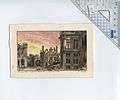
War ruins in Chauny, in the Aisne, France; 20 August, 1917.
-
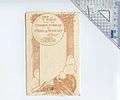
Reverse of previous; numbered 313504
-
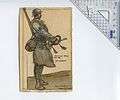
Chemin des Dames Déc. 1917 "UN CLAiRON"
-
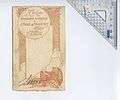
Reverse of previous; numbered 33555
-

Mahdia. La Jétée
-

Reverse of previous; numbered 36663' - variant wording "The Comité des Étudiants Américains de l'École des Beaux-Arts Paris guarantee the authenticity of this picture"
-
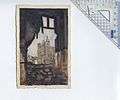
TiLLOLOY - 1917 - signed "SOLD" - war ruins at the Chateau Tilloloy
-

Reverse of previous; numbered 36747'
-
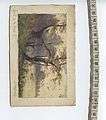
A view of the Bievre River
-
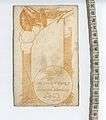
Reverse of previous; numbered 37564 - variant wording "The Comité des Étudiants Américains de l'École des Beaux-Arts Paris guarantee the authenticity of this picture"
Other/number-status unknown/etc.
-

A group of 4 cards
-

Reverses of the previous 4 cards
-

A group of 5 cards, all signed with the name "SOLD"
Gazette de l'Ecole des Beaux-Arts
The organization also published a periodical during this period, the Gazette de l'Ecole des Beaux-Arts. It was offered for sale by subscription, and may have been provided free of charge to serving students/alumni. The Gazette served as a means to inform students who had been mobilised, of school activities and relevant news; as well as providing another source of fund-raising for the group. The Comité also helped and inspired student groups at other French arts-schools to produce similar wartime publications.
From the limited information available, the start-date, end-date, and number of editions produced are unknown; as are the quantities printed. The one example found online is the edition of October-November-December 1918, produced in January 1919. The Gazette was published in French, book-style, in a 2-column format; with professional newspaper-quality printing in black ink, on what looks like unfinished (i.e.: no coating, glossy or satin) paper of a fairly heavy grade of slightly rough newsprint. This volume has about 41 printed pages, with some blanks at the end. Aside from the cover illustration (drawing) and some minor decorations around the text on a few pages, and 1 page (single-side, on glossy paper) of black & white photographs, the rest of the material is entirely in text-form. It includes a notice-page of deaths, promotions, etc. of students/alumni serving in the military; articles about the war; news of the school; news & information of interest to art-professionals; and some pieces relating to student-politics. The general tone is patriotic, and generally uncritical of the war as conducted by the French government. There is no inclusion of pacifist material, and only limited representation of leftist views; nothing "revolutionary", pro-communist, or otherwise hard-core "Red". As the single example of the gazette presently available, when preparing this article, and as an edition produced after the French & Allied victory in the War, it is difficult to judge how representative of the rest of the series this particular volume is.

See also
External links
- Europeana1914-1918.eu
- Albright, Alan. "Notable American Volunteers of the Great War." WWI WWW. n.p., n.d. Web. 19 May 2015
- http://net.lib.byu.edu/estu/wwi/memoir/Clearing/arch5.html
- "American Students' Committee of the École des Beaux-Arts postcard album, 1916-1917." WorldCat. WorldCat, n.d. Web. 19 May 2015
- "American Students' Committee of the École des Beaux-Arts postcard album, 1916-1917." Archivegrid. OCLC Online Computer Library Center, Inc., n.d. Web. 19 May 2015
- "Gazette de l'Ecole des Beaux-Arts. Editée par le Comité des étudiants ...." Gallica Bibliothèque Numérique. Europeana, n.d. Web. 19 May 2015
- "Fiche Document : 1726GJ 00002 - PARIS, A L'ECOLE DES BEAUX-ARTS, INAUGURATION PAR." Gaumont Pathé Archives. Gaumont Pathé Archives, n.d. Web. 19 May 2015
- http://arcade.nyarc.org/record=b1082779~S1
- http://library.sc.edu/socar/mnscrpts/christensen.pdf
- http://argonnaute.u-paris10.fr/Collections/p59/Les-Gazettes-d-ateliers-de-la-Grande-Guerre
- https://books.google.ca/books?id=-OO1CgAAQBAJ&pg=PT361&lpg=PT361&dq=Comit%C3%A9+des+%C3%89tudiants+Am%C3%A9ricains+de+l%27%C3%89cole+des+Beaux-Arts&source=bl&ots=glHKoCdhzp&sig=oeaKbdPS0CbAjE2mfYK7WhwEMWo&hl=en&sa=X&ved=0CCkQ6AEwCWoVChMIsv_r4p-XyQIVSjo-Ch19xgKL#v=onepage&q=Comit%C3%A9%20des%20%C3%89tudiants%20Am%C3%A9ricains%20de%20l%27%C3%89cole%20des%20Beaux-Arts&f=false
- https://books.google.ca/books?id=Sy5ybpknwKcC&pg=PA500&lpg=PA500&dq=A+Son+at+the+Front+edith+wharton+comite+etudiants+beaux+art&source=bl&ots=-_R1_NN24d&sig=s4UvEa1Vkadn6x1WGU901SAL1JE&hl=en&sa=X&ved=0ahUKEwjT1sG4zZ7JAhVJHR4KHdecDEIQ6AEIHzAA#v=onepage&q=A%20Son%20at%20the%20Front%20edith%20wharton%20comite%20etudiants%20beaux%20art&f=false
- https://www.google.ca/search?sclient=psy-ab&hl=en&site=webhp&btnG=Search&q=ronald+simmons+1885+1918
- https://www.google.ca/search?sclient=psy-ab&client=ubuntu&hs=nZP&channel=fs&btnG=Search&q=FRANK+RONALD+SIMMONS+1885+1918
Dupuy.WWI_postcard_art.Wittig_collection.item_40.obverse.scan.jpg)